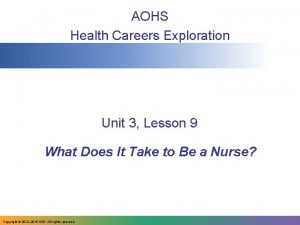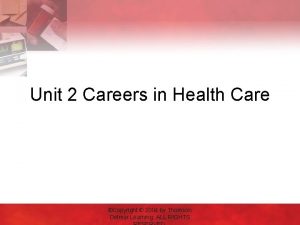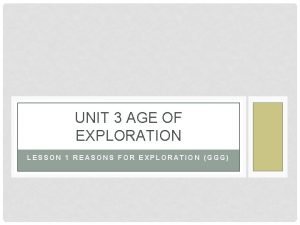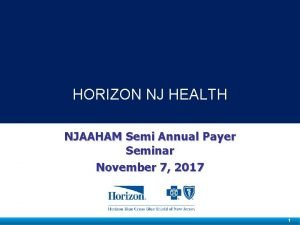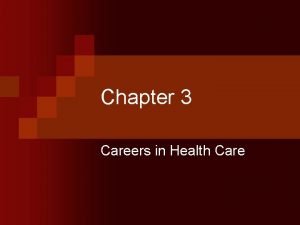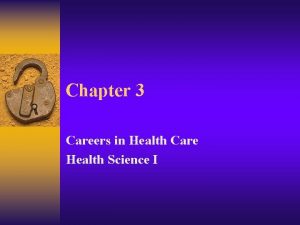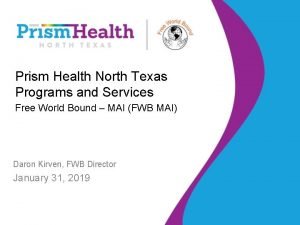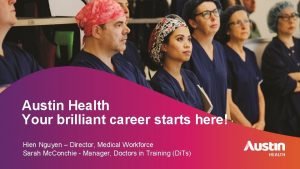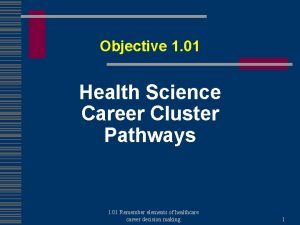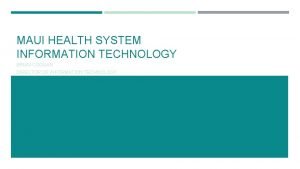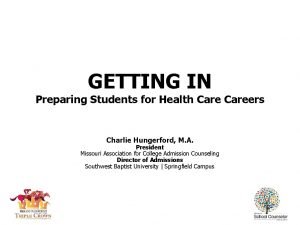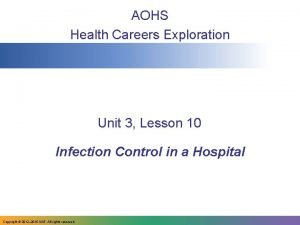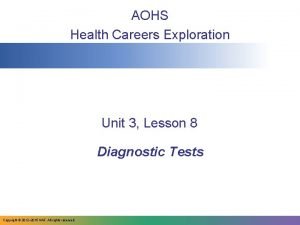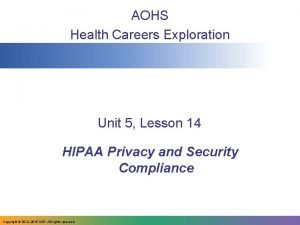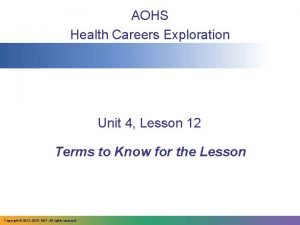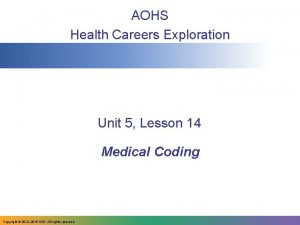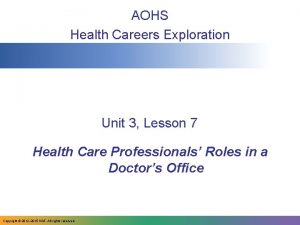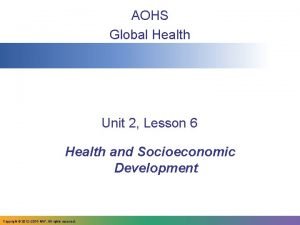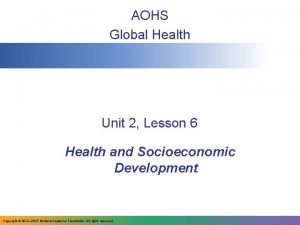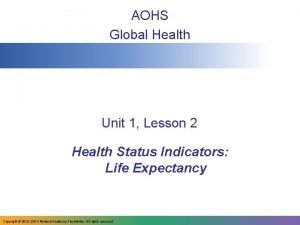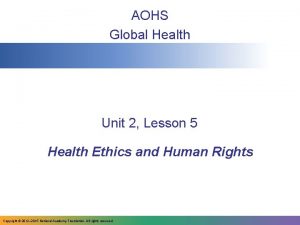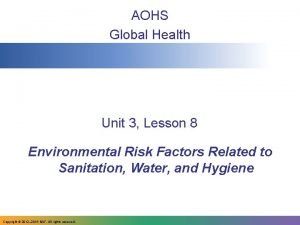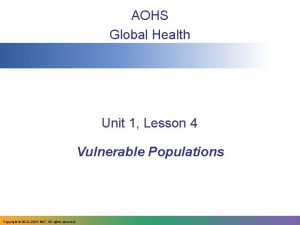AOHS Health Careers Exploration Unit 1 Lesson 3



















- Slides: 19

AOHS Health Careers Exploration Unit 1, Lesson 3 Health Career Pathways Copyright © 2012‒ 2015 NAF. All rights reserved

Health careers are divided into categories called pathways Diagnostic services Support services Therapeutic services Health informatics Biotechnology research and development

One career pathway is diagnostic services • ECG technician • Radiologic technologist • Phlebotomist • Optometrist • Dentist Phlebotomists draw blood • Diagnostic medical sonographer • Nuclear medicine technologist What do you think these careers have in common? Discuss your ideas with a partner, and then share your ideas with the class.

Diagnostic services Workers in diagnostic services diagnose disease and injury Health care workers in diagnostic services perform tests and evaluations on patients. These tests help detect, diagnose, and treat disease and injury. People who work in this pathway often use diagnostic image technology, like an ultrasound, X-ray, and MRI. A patient is diagnosed using a sonograph, or an ultrasound. What do you think people might enjoy about working in diagnostic services? What do you think some of the challenges might be?

Diagnostic services Routine eye exams and nuclear imaging are both diagnostic services An optometrist performs eye examinations on patients. Optometrists look for problems such as cataracts, nearsightedness, and farsightedness. If a problem is discovered, the optometrist may prescribe a treatment, such as glasses or corrective lenses. A nuclear medicine technologist gives a patient drugs with a small amount of radioactivity. Then the technologist uses a special machine to take images of the inside of the body. A physician looks at the images to see if there are tumors or problems with the organs. Why do you think these jobs are in the same pathway?

Another career pathway is therapeutic services • Mental health counselor • Dental hygienist • Nutritionist • Physical therapist • Pharmacist • Oral surgeon • Speech-language therapist Nutritionists educate people about healthy eating. What do you think these careers have in common? Discuss your ideas with a partner, and then share your ideas with the class.

Therapeutic services Workers in therapeutic services work directly with patients to improve their condition Health care workers in therapeutic services work to improve the condition of patients who are injured or sick, physically or mentally disabled, or emotionally troubled. They provide care, treatment, counseling, and education. Pharmacists provide medication to patients. Think about people you have met who work in therapeutic services, such as doctors and nurses. What character traits do they have in common?

Therapeutic services Physical therapists and oral surgeons provide therapeutic services Physical therapists have patients with head or neck injuries, arthritis, and amputations • Help patients restore the ability to move • Reduce pain and discomfort Oral surgeons perform mouth and jaw surgery • Procedures like removing impacted teeth and fixing jaw structure help relieve pain. • Emergency surgery helps patients who have been injured. Why do you think these jobs are in the same pathway?

A third career pathway is health informatics • Health information management administrator • Medical illustrator • Admitting clerk • Medical librarian • Epidemiologist • Health educator • Medical coder Medical illustrators create illustrations like this. What do you think these careers have in common? Discuss your ideas with a partner, and then share your ideas with the class.

Workers in health informatics document and process patient records and health information Health informatics • Don’t usually provide direct patient care • Responsible for documenting patient records and health information • Includes Performance Improvement (PI) and Quality departments What skills do you think are valuable to have if you work in health informatics?

Health informatics Epidemiologists and medical coders work in health informatics Epidemiologists determine what causes diseases and how to stop them from spreading. They work for hospitals, universities, and governments. They must be skilled in statistics. Public health decisions are often based on their reports. For hospitals and medical providers to receive reimbursement from insurance companies, they must submit reports that have a code for each procedure. Medical coders are responsible for correctly filing these codes. Why do you think these jobs are in the same pathway?

A fourth career pathway is support services • Hospital maintenance engineer • Biomedical technician • Interpreter • Environmental health advocate • Industrial hygienist • Mortician/funeral director • Food safety specialist Biomedical technicians repair machines like this. What do you think these careers have in common? Discuss your ideas with a partner, and then share your ideas with the class.

Support services Workers in support services create safe environments Workers in support services work behind the scenes to create clean and safe environments. They do jobs like making sure that health care facilities function properly and that safety standards are met. Restaurants and grocery stores must meet health and safety standards. What do you think are some of the rewards and challenges of working in support services?

Support services Biomedical equipment technicians and interpreters are in support services Interpreters help patients who don’t speak English communicate with medical staff. They understand medical terminology. Sign language interpreters help deaf patients communicate with medical professionals. Biomedical equipment technicians repair and maintain equipment at hospitals, clinics, and medical provider offices. They have the skills to care for equipment like dialysis machines and surgical equipment. Why do you think these jobs are in the same pathway?

Medical facilities categorize some of the careers in support services as “patient care services” Support services Patient Care Services Nurse educator Medical social worker Marriage family therapist • Support diagnostic and therapeutic services • Directly involved with managing patient care Why do you think these jobs can be categorized as patient care services?

The final career pathway is biotechnology research and development • Toxicologist • Biomedical chemist • Forensic scientist • Molecular biologist • Geneticist • Pharmaceutical scientist Forensic scientists study fingerprints. • Processing technician What do you think these careers have in common? Discuss your ideas with a partner, and then share your ideas with the class.

Biotechnology research and development There is an unlimited potential for the use of biotechnology Workers in biotechnology research and development use living cells and their molecules to make useful products. They produce new diagnostic tests and create new forms of treatment, medications, and vaccines. Biomedical chemists create new vaccines. How would you describe biotechnology in your own words? Why do you think people in this field are excited about their work?

Biotechnology research and development Toxicologists and geneticists are in biotechnology research and development Toxicologists are involved with the safety of products that contain chemicals, from house paint to cleaning products used by major industries. They use biotechnology methods to conduct their research and learn about toxins at the molecular level. Geneticists are scientists who study genes. They use biotechnology methods to study how genetic diseases are inherited. They also provide information to families who have genetic disorders. Other jobs they have involve making pharmaceuticals and using genetics to make new crops. Why do you think these jobs are in the same pathway?

Looking at pathways helps you see similarities in the careers that interest you • Diagnostic services: diagnosing disease and injury • Therapeutic services: providing care, treatment, education, and counseling • Health informatics: documenting patient records and health information • Support services: working behind the scenes to create clean, safe environments • Biotechnology research and development: using living cells to make useful products
 Aohs health careers exploration
Aohs health careers exploration Unit 3 lesson 9 health science
Unit 3 lesson 9 health science Unit 2 careers in health care
Unit 2 careers in health care Aohs foundations of anatomy and physiology 1
Aohs foundations of anatomy and physiology 1 Aohs foundations of anatomy and physiology 1
Aohs foundations of anatomy and physiology 1 Aohs foundations of anatomy and physiology 1
Aohs foundations of anatomy and physiology 1 Aohs foundations of anatomy and physiology 1
Aohs foundations of anatomy and physiology 1 Aohs foundations of anatomy and physiology 1
Aohs foundations of anatomy and physiology 1 Aohs foundations of anatomy and physiology 1
Aohs foundations of anatomy and physiology 1 The age of exploration lesson 1
The age of exploration lesson 1 Horizon nj health careers
Horizon nj health careers Chapter 3 careers in health care
Chapter 3 careers in health care Chapter 3 career in health care
Chapter 3 career in health care Njhealth horizon
Njhealth horizon Prism health oak cliff
Prism health oak cliff Austin health careers
Austin health careers 5 health science career pathways
5 health science career pathways Maui health system careers
Maui health system careers Charlie health careers
Charlie health careers Chapter 3 careers in health care
Chapter 3 careers in health care

